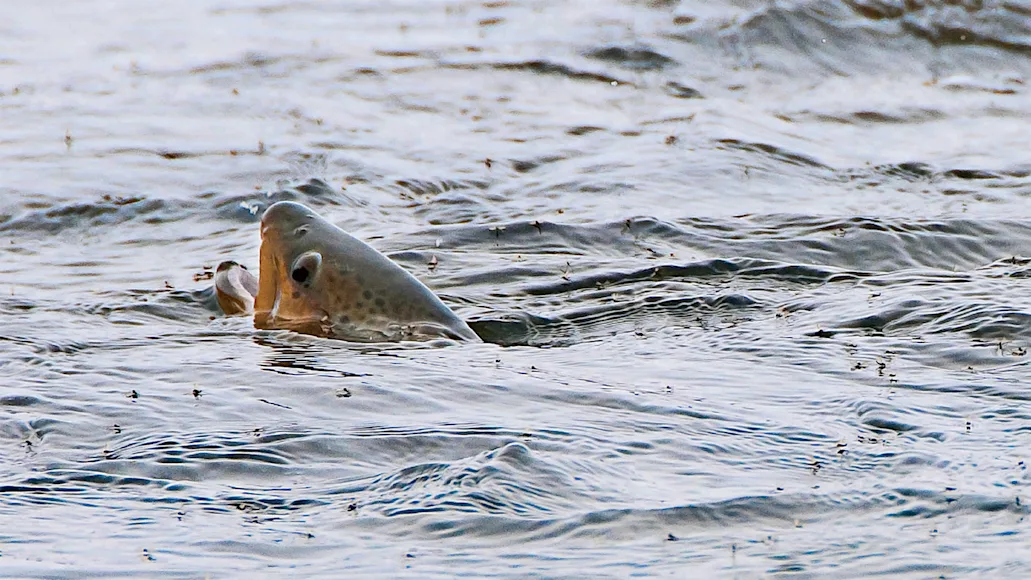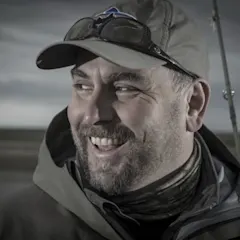Shortly after daybreak, on a hot, grimy Montana morning, Pete Cardinal and I stood knee-deep in the Missouri River and watched fies flutter by the thousands. Thick gray columns of the bugs wafted like smoke plumes over the foamy eddy upstream. The trout were already dialed in, swirling and gnashing at the surface, their mouths clicking and popping like castanets. An epic hatch was happening right before us—and I was feeling anything but confident.
“We would be damn lucky,” I told Cardinal, “if these were any other bugs but Tricos.”
I pawed through my box of minuscule, white-winged dry flies, nudging Cardinal to show him what I had in mind. He shook his head. “Just keep watching,” he said. “We’re not ready to fish yet.”
Sweat the Small Stuff
In spring, trout are happy. They’ve gotten through winter, and now they get to enjoy one mayfly smorgasbord after another. By the time those spring hatches taper off, though, the trout—particularly those on big, busy rivers like the Missouri—have become educated and are harder to catch. They stay that way until late summer, when even the smartest trout cannot resist striking a hopper and the glob of protein that comes with it.
Tricos are the intermezzo hatch for spring and late summer—a mayfly hatch in terrestrial season—and more finesse and skill are required to catch trout during a Trico hatch than at any other time of the year. The bugs arrive in midsummer, but you never know when a hatch will happen, especially a really good one. You just have to keep grinding out river miles, hoping to show up in the right place at the right time. When you finally do time it just right, you then have to figure out exactly what you’re looking at, because these bugs hatch in three phases: First, the male duns show up (usually at night); then the females (usually early morning); finally, after a mating swarm, the adult spinners fall back to the surface. And the kicker is that all these bugs are tiny—size 20 to 28. Catching trout on flies this small can be one of the most frustrating challenges in fly fishing.
It can be one of the most rewarding, too—a rite of passage, even.
My first Trico-caught trout was memorable. I was fishing on the Dream Stream section of the South Platte, when I saw a big brown chomping away at a steady trickle of small bugs I assumed were Tricos. After sizing down to a 7X tippet, I tied on a white-winged spinner fly and dropped it right on the seam. The fly was so small I didn’t even see the fish eat it; I only noticed that the white wings had disappeared in a little dimple when the trout sucked it down. That fish measured 22 inches—and was caught on a size 22 fly.
Related: The 25 Greatest Fly Patterns of All Time
The Zen of When

Cardinal opened his fly box. “Here, tie this one on,” he said. “All they’ll really want is that white wing.” He handed me a size 20 House and Lot Variant—a gaudy old-school pattern I was pretty sure would send all the rising fish scurrying for cover as soon as it hit the water. But I tied it on anyway.
I stripped the line, measuring what I thought I’d need to reach the fish, then went into my windup. Cardinal threw his arm in front of me to put on the brakes. “Wait,” he whisper-shouted. “You have to wait for the water to be right. Watch the foam. Watch what happens when the bubbles move.”
So I fixed my gaze on the run upstream, which was formed by a boulder jutting into the current. Water flowed around that rock, creating a seam to the left and an eddy to the right, and where the current met the glassy water was a foam line.
Only it wasn’t a static foam line—it was like an amoeba changing forms. When the bubbles dispersed and spread like egg whites in a hot skillet, the fish fed very sporadically. But when the foam contracted into a well-defined, comma shaped swirl, the trout would go off all at once.
Pop. Pop. Pop.
Then the foam would spread out again, and all that happened was the occasional stray slurp. Seconds later, the swirl re-formed and the trout noses reappeared.
Pop. Pop. Pop.
“That current is collecting the bugs,” Cardinal said. “Fire your cast in tune with the river. That’s how you catch these fish. It isn’t about the bug. It’s about the when.”
I followed Cardinal’s direction…and caught a fat rainbow on my first cast that truly mattered. We landed and released the fish, then waited for the moment when the currents lined up again. I made another cast and caught another decent fish—and I did it with a fly that was probably three times the size of the tiny spinners in my box.
Cardinal’s strategy makes perfect sense, really, because trout, like some Americans, want to eat as much as they can while exerting as little effort as possible. This is especially true during a hatch with tiny dries. Why eat one bug at a time when the right pass might earn a mouthful? I’ve since learned that Cardinal is not alone in what I call the “Zen of when” approach to small-fly hatches. Other guides I’ve fished with are equally apt to tie on a bigger fly and wait for that moment to present the pattern. They’ve made a believer out of me. Which is why my box of absurdly small black-and-white flies is now officially retired.
When to Fish the Trico Hatch
Tricos are clambering, slow-water nymphs that often favor the weedy, silty margins of large trout pools, rather than tumbling freestone water. Most American trout rivers that remain cold enough to hold active trout in August, meaning generally below 70 degrees, also have large numbers of tricos. Hatches are very predictable, occurring from about mid-July through some portion of September. Spinner falls, which concentrate the bugs in the greatest numbers, usually take place in the morning and are the most important phase to trout and anglers alike. Common knowledge among anglers has been that spinner falls happen when the morning air temperature reaches 68 degrees. I’ve seen exceptions, but if you need a rule to follow, use that one.
High winds or morning thunderstorms will prevent or disperse the spinner swarms and thus kill the fishing. Checking the local weather forecast the night before you plan to fish can tell you whether or not to rig your gear. You also may find out what time to be on the water according to the predicted air temperature. The flies will be fluttering a few feet above the water and looking like small, crystalline snowflakes as the morning sunlight reflects brightly off their wings. Very shortly, you’ll see a gentle rise, and then another. That means it’s time to look carefully to see what the trout are actually doing.
How to Cast to Trico-Eating Trout
A trout’s behavior can vary widely when it’s feeding on tricos. Making note of your target trout’s behavior before you start casting can radically enhance your success. If the flies are abundant, some trout start feeding with a distinct rhythm. Count the seconds between rises and then time your cast so that the fly arrives near the trout’s nose just as the next rise is due.
Other trout may be cruising, slurping their way along the length of a backwater or eddy, and then swimming back downstream to repeat the process. Once you’ve noted the pattern, plan your casts to intercept them. Still other trout—often the largest ones—will be tight to the bank in slow-moving currents, rising with gentle dimples that belie their bulk. In that case, working the rises carefully can net a trout measured in pounds rather than inches.
In almost all cases, trico-feeding trout seem to have microscopes for eyes, and their selectivity can be mind-boggling. They can even tell the difference between male and female mayflies that are less than ¼-inch long and can leave you tearing your hair unless you know what to do next.
The Best Trico Fly Patterns
The standard fly is a trico spinner with a black body and flat, outstretched wings of a white or clear material in sizes 20 to 26. This male-spinner pattern is what everybody uses, which is why you should use something else. On pressured water, trout have learned to discern the phonies. Then, too, fly-pattern variations can help trout pick your fly from among thousands of naturals.
Black-bodied, upright, parachute-style dries can work well during the spinner fall. Another variation that works extremely well is a parachute tied with a dark green abdomen. This represents an egg-filled female spinner, which—as arcane as it might sound—trout will sometimes readily accept after refusing a conventional spinner pattern.
Four- and 5-weight rods are perfect for this fishing. Remember to set the hook on a strike with a deliberate uplifting of your rod arm rather than a sweeping hookset that will snap a fine leader. Larger fish will sometimes run fast and far when first hooked, and your reel’s drag needs to be ultra-smooth.
The foregoing may sound absurdly technical and difficult to some, but with the right gear and clues to the hatch, it can be relatively easy to score. Just remember to watch patiently and adapt to what’s happening on the water. The trout make the rules here. All you have to do is understand them.
How to Fish Dirty During a Trico Hatch
When trico spinner falls happen early in the morning, they coincide with the prowl time of the biggest brown trout. More than once, I’ve seen a pod of smaller, mayfly-sipping trout erupt in spray as a brown chomped one. For spinfishermen, it’s a great opportunity. Use a size 11 trout-finish floating Rapala, and twitch it carefully along bank-side logjams and other cover. Ignore the smaller trout and you might tangle with a real Goliath.



